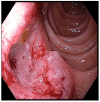Endoscopic Management of Ampullary Adenomas: A Comprehensive Review
- PMID: 40429526
- PMCID: PMC12112356
- DOI: 10.3390/jcm14103532
Endoscopic Management of Ampullary Adenomas: A Comprehensive Review
Abstract
Ampullary adenomas are rare outgrowths at the ampulla of Vater that may progress into cancer via the adenoma-to-carcinoma sequence, particularly in individuals with hereditary polyposis syndrome. Many are diagnosed incidentally or once the lesion becomes large enough to cause obstruction. Traditionally managed surgically with high morbidity and mortality, advances in imaging and therapy have made endoscopic ampullectomy the first-line treatment for noninvasive lesions. Despite its high success rate and favorable safety profile, complications such as pancreatitis, ductal stenosis, bleeding, recurrence, and perforation can occur. Recommendations for optimal endoscopic techniques and surveillance intervals are largely based on expert opinion in interventional endoscopy and findings from small-scale studies. This review provides an updated framework for the diagnosis and management of ampullary adenomas.
Keywords: ampullary adenocarcinoma; ampullary adenoma; endoscopic ampullectomy; endoscopic retrograde cholangiopancreatography; endoscopic ultrasound.
Conflict of interest statement
The authors declare that they have no competing interests.
Figures





References
-
- Kawashima H., Ohno E., Ishikawa T., Iida T., Tanaka H., Furukawa K., Nakamura M., Honda T., Hashimoto S. Endoscopic papillectomy for ampullary adenoma and early adenocarcinoma: Analysis of factors related to treatment outcome and long-term prognosis. Dig. Endosc. Off. J. Jpn. Gastroenterol. Endosc. Soc. 2021;33:858–869. doi: 10.1111/den.13881. - DOI - PubMed
-
- Karam E., Hollenbach M., Abou Ali E., Auriemma F., Gulla A., Heise C., Regner S., Gaujoux S., Regimbeau J.M., Kähler G., et al. Outcomes of rescue procedures in the management of locally recurrent ampullary tumors: A Pancreas 2000/EPC study. Surgery. 2023;173:1254–1262. doi: 10.1016/j.surg.2022.12.011. - DOI - PubMed
Publication types
LinkOut - more resources
Full Text Sources

